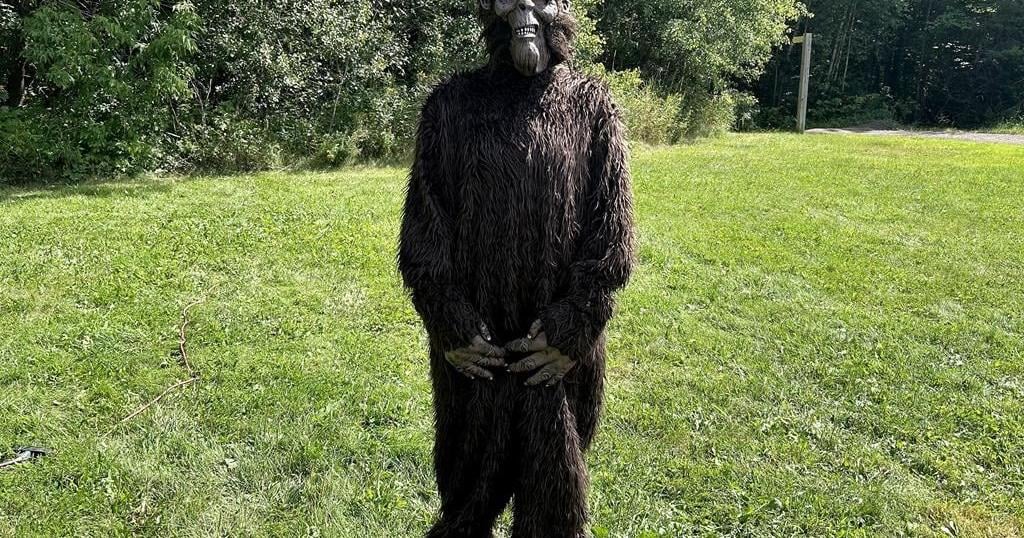MONCTON, N.B. – Ann Marie Reinhart was enjoying a peaceful day’s fishing near southern New Brunswick’s Kingston Peninsula when a sound between a howl and a scream tore through the air.
Birds fell silent, she said, in response to the four eerie calls that sounded like they came from two distinct sources.
“It was not of any animal I’ve ever heard, and I spent a lot of time in the woods,” Reinhart said, though she had little doubt about the creatures behind the noise.
She was among roughly 45 people who gathered at the Irishtown Nature Park in Moncton, N.B., on Saturday to swap stories about purported encounters with Bigfoot.
Tales abound in numerous cultures about a large, hairy, apelike creature who lives in the deep jungles or the snow-covered Himalayas. It’s known by many names — Bigfoot, Sasquatch and Yeti among them — and while its origins are still widely considered the stuff of legend, many firmly believe Bigfoot exists.
Tyler Paul, organizer of Saturday’s conference, said he began the New Brunswick Bigfoot Organization two years ago and held its first gathering last year in Sackville.
The goal, he said, is to encourage more people to talk about their personal experiences.
Paul believes his first brush with Bigfoot came last June as he hiked a woodland trail with his family in Elgin, N.B.
“We started hearing this knocking … just this constant, whack, whack, whack, whack,” he said, adding the sounds continued for four or five minutes.
“And I was kind of getting a little freaked out because I had the kids there and everything, and gave my wife a little look like, ‘is it really what I’m hearing?’ We believe that we found an imprint on the ground.”
Suzanne Leger of Shediac, N.B., has reported two encounters. She said the first came when she was about seven or eight and playing with a friend in her backyard when they heard “really, really loud screams.”
“It’s not like an animal, not like a man. And they’re very, very loud and very strong, powerful.”
The second came this February, she said, during a lunchtime stroll down a trail in Grande-Bigue, N.B.’s Cocagne Park. She heard nothing this time, but said she saw three different sets of footprints, some of which featured indentations that looked like claw marks. Leger said they bore no resemblance to imprints made by animals and is convinced a Bigfoot clan was on the move.
“It looked like a family,” she said, noting one set of footprints was larger than the others.
Folklore is filled with centuries worth of suspected Bigfoot sightings, which Leger cites as reason enough to believe her encounters were genuine.
“People aren’t making this stuff up for hundreds of years — There’s something there that we just haven’t seen,” she said.
The enthusiasts in Moncton are far from the only ones to be captivated by Yeti yarns.
Ryan Willis, founder of the Sasquatch Society at Ontario’s Trent University, co-hosts a tv show on the subject — the second season of ‘Sasquatch University’ will air on Wild TV next month.
While shooting Season 2, crew members enlisted psychics to both help with the hunt and bridge an ideological divide among the community of Bigfoot believers.
“You have some people who think (Bigfoot) are strictly like a flesh and blood animal,” he said. “Other people say they can teleport between different dimensions and things. … A lot of people recommend bringing psychics out to try to connect if there is a chance that they’re on a more interdimensional type of frequency.”
Devotees contend it’s not just one Bigfoot who roams the world. There are many Bigfoots (the plural), they say, including families.
Despite the stories and sightings, however, Bigfoot’s existence has yet to be proven. The United States’ Federal Bureau of Investigation, which probed Bigfoot claims in 1977, found that hair submitted for testing actually came from a deer.
In 2014, an Oxford University study published in “The Proceedings of the Royal Society B” journal tested more than 30 hair samples, matching them to dogs, sheep, raccoons, bears and other animals.
“While it is important to bear in mind that absence of evidence is not evidence of absence and this survey cannot refute the existence of anomalous primates, neither has it found any evidence in support,” said the paper.
That has not deterred the believers.
Toward the end of the nearly two hour conference on Saturday, participants competed in a howling contest presided over by a judge dressed as Bigfoot.
Reinhart won by mimicking the call she heard in July. Then after posing for a few pictures with enthusiasts and confessing to feeling hot in the sun, Bigfoot melted back into the woods.
This report by The Canadian Press was first published Aug. 25, 2024.
